June 20, 2025 | 02:15 GMT +7
June 20, 2025 | 02:15 GMT +7
Hotline: 0913.378.918
June 20, 2025 | 02:15 GMT +7
Hotline: 0913.378.918
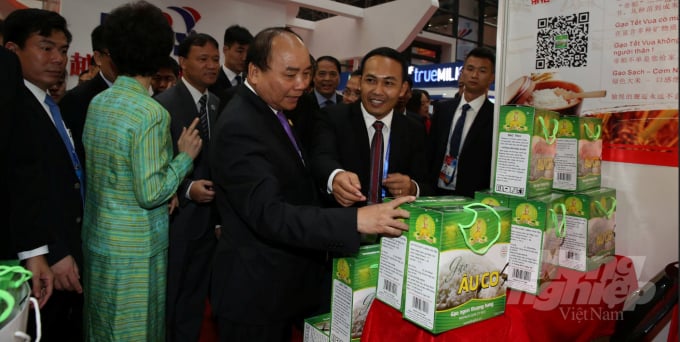
Former Prime Minister Nguyen Xuan Phuc visited Tran Van Trung's ST rice stall at CAEXPO in Nanning, China in 2016. Photo: NVCC.
"But ST24 rice is just in top three of the world's best rice! My rice variety, the more we chew the more delicious it is because the variety is cultivated in the sandworm field with one crop per year. The field and rice paddies are nurtured with blackish silt." To prove his words, Do Danh Hung living in Bai Sau, Ngu Phuc commune ( Kien Thuy district, Hai Phong City) invited me to have a meal. The lunch was served with only a bowl of soup, few pickled eggplants, a dish of fried shrimps but I ate up three bowls of rice and asking for a big piece of scorched rice more.
I took off my face mask to breath freely in the air wafting in the scent of new rice harvest. Looking up at the sky, I saw a few couple of storks and bitterns. Looking down on the field, I saw holes of crabs and sandworms flaring on the surface of water.
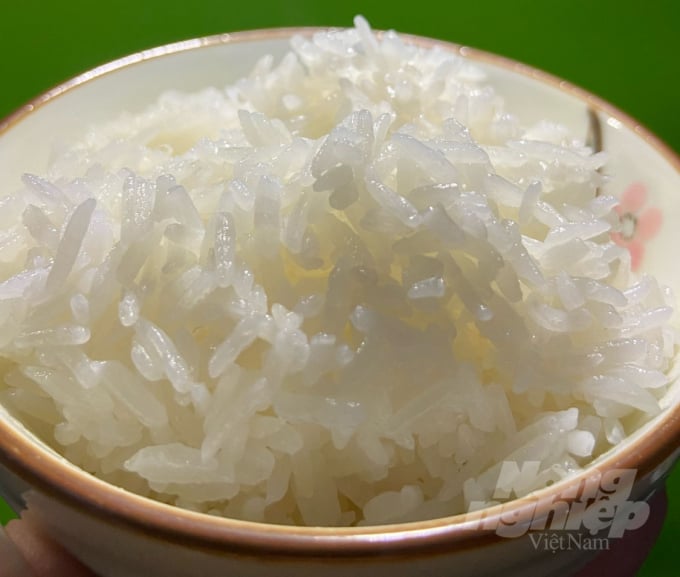
Rice is cooked from ST25 rice . Photo: NVCC.
After wading through the mud soft and cool, Hung rowed me to the middle of the spacious golden rice field. This is the first crop he has moved to growing ST25 rice variety. Although the rice variety has not yet been harvested it promises to be even more delicious than ST24 rice which is well-known because it is still the world's best rice.
In 2017, Hung and his wife and a household made a plan on growing rice on large scale and aquaculture following safety standards. They got an approval of Hai Phong city for leasing land for 50 year tenure. And, they had to pay VND 260 million per 32 hectares per year. When they received the land, it was covered with weeds and grass and only a few clusters of rice could be transplanted.
Everyday, they had to travel more than 10 kilometers from their house in the city to here to work in the field and take shelter from the rain in a makeshift hut. They spent a lot of money, efforts on building road, ditch, culvert and improving the ground.
At that time, Tran Van Trung, Director of Hai Au Viet Investment Joint Stock Company (Owner of "Tien Vua Rice" trademark - Kien Quoc) and Tien Vua Agricultural Joint Stock Company (Specialized in seeds) were looking for a partner to grow rice. Seeing the hard-working couple they just thought they were hired workers but couldn't believe that they were the owners of the land. It rained suddenly. Although guests and householder took shelter in the hut, they were wet to the skin. The meeting between the sandworm field and ST rice variety was predestined.

Hung is rowing to check the rice paddy field. Photo: Duong Dinh Tuong.
During the implementation process, because of different ideas, the two owners decided to cut the field in half. Each half was 16 hectares. The more working in the field the more Hung got addicted to the farm affairs. On Tet holiday, Hung's wife returned to their house in the downtown. After cleaning up she called him to get back home to give offerings to ancestors, he blurted out:"I'm at my home (hut) where else can I go?"
365 days in a year, he spent 364 days in the field. He couldn't count how many hours per day he worked and how many times per night he got up depending on tide up and down. He went out to close and open the culvert and cast the net. Just oversleeping, no water in, he would lose aquatic resources right away.
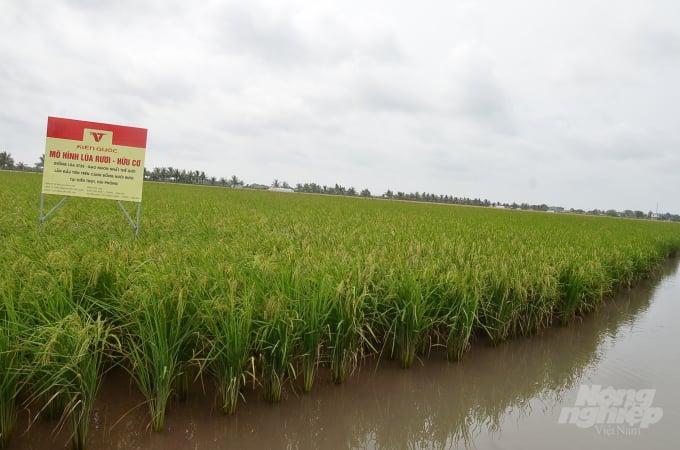
ST 25 variety is cultivated in the sandworm field in Hai Phong. Photo: Duong Dinh Tuong.
After planting the ST variety, rat from all corners gathered in the field because seedlings of this rice variety was so fragrant. In the flowering stage, the rice field was attacked severely by rats. Therefore, in this stage, Hung had to go hunting rats every night.
Rice paddy field and sandworm lagoon is a closed ecosystem. With the main purpose of harvesting sandworms, they only grow rice one crop a year without using chemicals and pesticides to soften the soil and to make a shelter of shade for sandworms. On the contrary, in the sandworm season, their heads emerge while their lower parts dead to nourish the rice plants.
Previously, Hung and his wife did not apply any fertilizer but just transplanting right after preparing the soil. However, recently they have invested in composting 500 tons of organic fertilizer and spreading in the field to improve the soil.
In the past, dried unhusked rice of the lower-quality varieties was sold at VND 5,000 per kilogram. Now, fresh unhusked ST 25 rice is priced at VND 12,000 per kilogram. However, it will be at a loss if it only depends on rice only because organic farming need huge investment. For example, 500 tons of organic fertilizer cost up to VND 1.5 billion but output is just 1.2 - 1.3 quintals or rice per sao. This year, the harvest is good so output can reach 1,5 - 1.5 quintals per sao. On average they earn VND 2 billion from sandworms, VND300 million from shrimps, fishes, crabs, from VND 600 million - to VND 700 million from rice. They get a net profit of over VND 1 billion after counting all expenses.
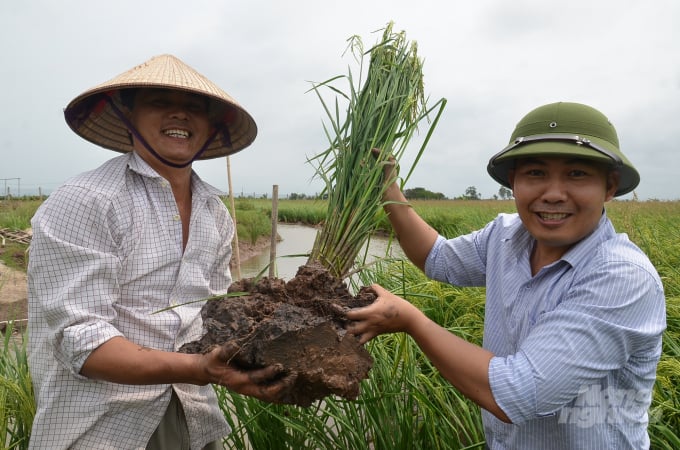
The rice root is strong thanks to growing in the sandworm field. Photo: Duong Dinh Tuong.
Although the sandworm fields are thought to be uncontaminated, it's not always true. Not far from Hung's field, the locals' sandworm fields are still applied chemical fertilizers and pesticides because their fields are not large enough, if they don't do so they will have nothing to harvest. After harvesting rice, these fields are available for lease for aquaculture; hence sandworms become the secondary source of income.
Every afternoon, after finishing their work, Hung and his wife went for a walk around the field with their dogs. They went see the change of the rice paddy field day by day which made them joyful everyday. However, they faced failures many times. At that time, they felt upset but could not cry, they felt so depressed that they just wanted to give up.
That was the beginning. Because of lacking experiences and skills, they hired a combine harvester to harvest rice but the straw was not removed from the field then they took water to soak the field immediately which created toxic gas killing tens of tons of sandworms. It took two years for the field to recover. But afterwards the historic salt intrusion 2020 occurred. The field was only 10km from the estuary, the jellyfishes still swarm into the field. When the water receded it left a layer of white salt on the surface of the field. Rice, sandworm, shrimps and fishes were all dead.
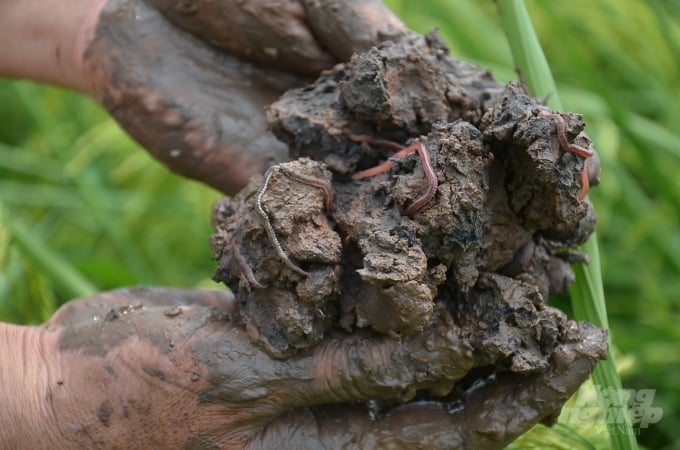
Young sandworms under the rice root. Photo: Duong Dinh Tuong.
Back to the story of " Northward" of ST rice varieties. About five years ago, Tran Van Trung, Director of Hai Au Viet Investment Joint Stock Company took ST20 and then ST 24 to his hometown in Hai Hau district, Nam Dinh province.
The local authorities after trying rice cooked from the ST varieties, they were fascinated so they decided to grow the varieties in trials in 33 communes and towns. Each locality, 50 kilograms of seed was sown. In 2016,Trung took ST24 rice variety to CAEXPO in Nanning, China. Prime Minister Nguyen Xuan Phuc visited the company's stall to encourage the team.
When guests tried rice from Thailand, Cambodia and Vietnam, many chose ST24 variety as the best rice and 3.5 tons of rice were sold out. Earlier, Trung used to sell ST24 rice in Mong Cai (Quang Ninh). Chinese people along the border between Vietnam and China bought and saw that the rice variety was so flavorous that some enterprises traveled to Nam Dinh to offer the cooperation for rice export.
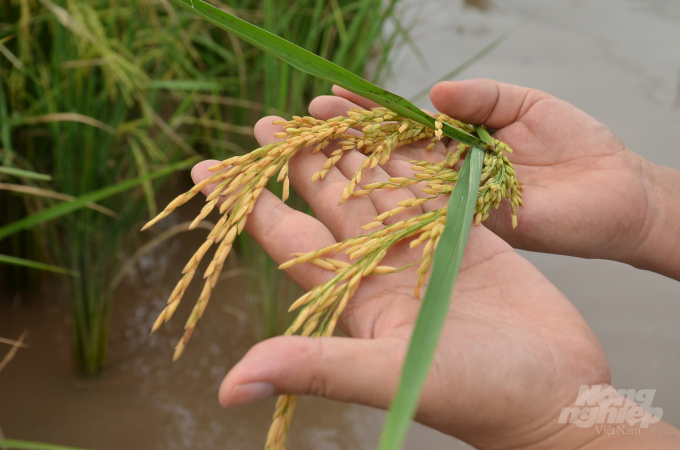
An ear of ST25 rice. Photo: Duong Dinh Tuong.
The partners agreed and signed an five-year exclusive contract but he couldn't perform the contract as agreed because the small businesses like him had to hire an unit to perform activities of exporting due to not meeting criteria. Moreover, the rice cultivation area was fragmented and small.
When ST25 rice won first prize in the World's Best Rice contest in 2019, apart from Hai Hau, other districts of Nam Dinh province such as Nghia Hung, Giao Thuy, Y Yen asked for growing trials of ST24 and ST25 varieties. The challenge was that these varieties were not recognized in the North so it was difficult to expand cultivation area . Trung estimated that his company now have about 300 hectares of ST24 rice while the area of ST25 rice is much lower.
Regarding taking ST rice varieties to the sandworm field, Trung said a few years ago, he worked as a sale agent of organic rice for a large company that spent up to VND70 billion to grow organic rice in U Minh Ha forest ( Ca Mau province). The rice product was of high quality but it was difficult to sell because of high prices.
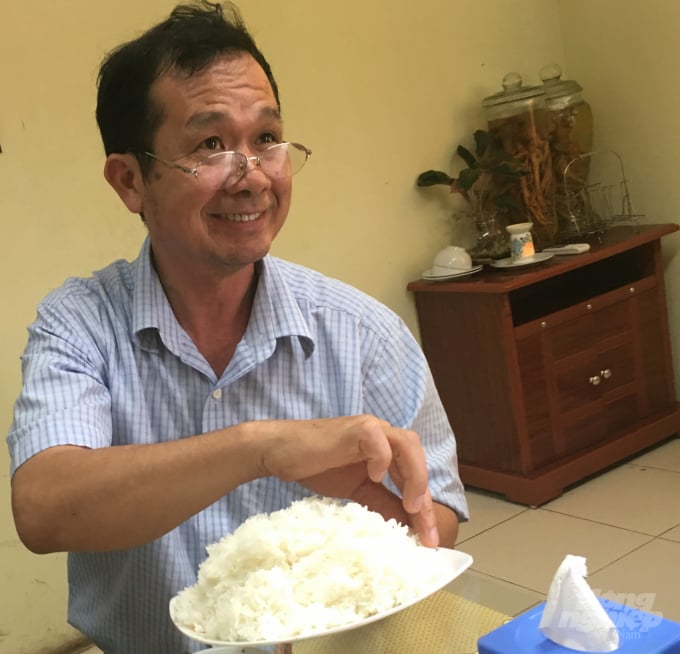
Le Van Dinh, Deputy Head of the Office of Agriculture and Rural Development of Hai Hau district (Nam Dinh) is trying rice cooked from the ST variety. Photo: NVCC.
When cooked, the standard ST rice looks like glutinous rice. It's soft but not sticky and very aromatic.
To have that quality, a variety of elements such as seed, soil, drying, preservation and the way of cooking must be ensured. Rice is harvested when the rice is 90% ripe. And the last one is that it's necessary to have good cooker.
In Hai Phong, there are two districts of Kien Thuy and Tien Lang having thousand hectares of sandworm fields. Growing rice in the sandworm fields is a cheaper and quicker way of organic farming because it takes advantages of available conditions of soil, clean water, clean air, saving 3-4 years to improve the soil while the price of rice is not less than VND 86,000. Currently, the sandworm fields growing ST rice varieties are granted organic certificate by TQC organization.
Cambodia has a rice-cow farming model ( one crop is for planting rice, one crop is abandoned for grass to thrive for grazing). If the Southern region has the rice-shrimp farming system, the Northern region has the rice-sandworm system. My most favorite thing is that in the rice-cow farming system or in the rice-shrimp farming system, pesticides and chemical fertilizers can be applied but in the rice-sandworm farming system, it is impossible. With the rice variety for the world's best rice along with unique environment and soil conditions , a rice product with distinct flavor was born. I set the target that I will do my part together with Ho Quang Cua (father of the ST rice variety) to take Tien Vua rice - ST25 rice grown in the sandworm field to join the world's best rice contest in the coming time" said Trung.
/2025/06/17/3942-2-143243_548.jpg)
(VAN) Recently, in Sweden, the Secretary of the Binh Dinh Provincial Party Committee presented the Investment Registration Certificate for the 'Polyester Fabric Recycling Complex' project to SYRE Impact-AB Company.
/2025/06/12/3721-2-202745_83.jpg)
(VAN) TH made an impression at Seoul Food 2025 with its line of natural beverages, paving the way for Vietnamese food products to enter the South Korean market.
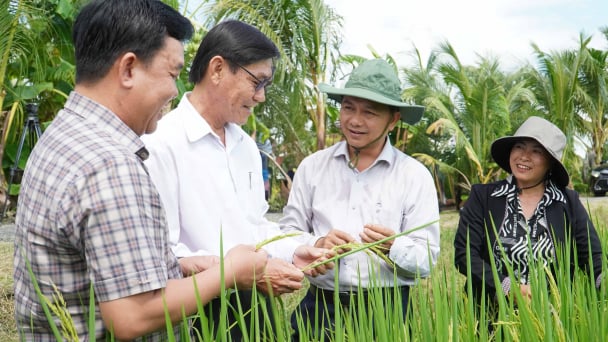
(VAN) Soc Trang's success in rice exports stems from a strategy of developing fragrant and specialty rice cultivation areas and standardizing production toward low-emission practices.
/2025/06/11/1311-5-120811_839.jpg)
(VAN) The pig farming industry is facing the challenge of comprehensive restructuring to meet requirements for quality, safety, traceability, and market expansion both domestically and for export.
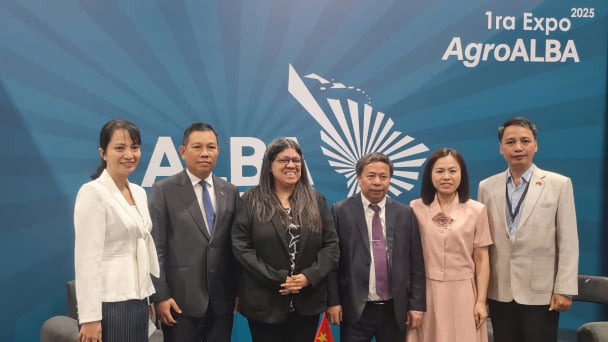
(VAN) Vietnam considers participating in ALGROALBA in order to expand agricultural production, coordinate the assessment and effective exploitation potential land.
/2025/06/05/5314-1-184727_407.jpg)
(VAN) From seemingly worthless fish scales and skin, enzymes and lactic ferments can transform by-products into peptides, opening a sustainable, effective business direction and elevating Vietnamese seafood.
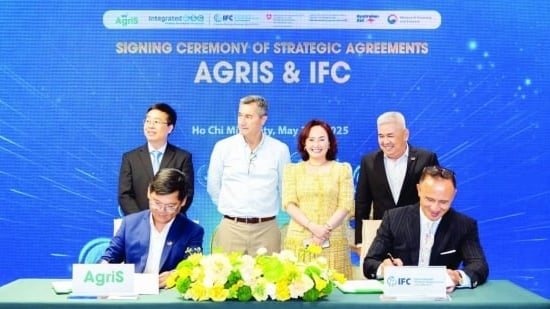
(VAN) TTC AgriS and IFC signed a strategic partnership to develop a sustainable agricultural value chain, aiming to achieve the Net Zero target by 2035.